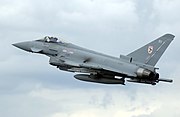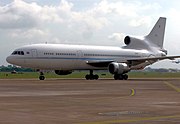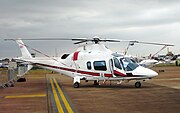Royal Air Force Military Aircraft
7:38 AM
Posted by Peace Keeper
| Aircraft | Origin | Type | Versions | In service | Notes | |
|---|---|---|---|---|---|---|
| Combat Aircraft | ||||||
| Panavia Tornado | Attack Aircraft | GR4 / GR4A | 136 | 13 and 14 squadron to be disbanded, "The RAF will retain five front line Tornado squadrons with a total fleet of 136 GR4 aircraft." | ||
| Eurofighter Typhoon | Multirole Fighter Aircraft | T1 / T1A / F2 / T3 / FGR4 | 64 | Confirmed order of 160 airframes. (72 as of yet uncommited) | ||
| Trainer Aircraft | ||||||
| Bell Griffin | Trainer Aircraft (Helicopter) | HT1 | 11 | |||
| Beechcraft King Air B200 | Mulit-engine Trainer Aircraft | 11 | One operated on behalf of Foreign & Commonwealth Office. | |||
| Eurocopter Squirrel | Trainer Aircraft (Helicopter) | HT1 | 26 | |||
| Grob Tutor | Trainer Aircraft | T1 | 94 | |||
| Grob Viking | Trainer Aircraft (Glider) | T1 | 82 | |||
| Grob Vigilant | Trainer Aircraft (Motor Glider) | T1 | 65 | |||
| Hawker Siddeley Hawk | Trainer Aircraft (Advanced) | T1 / T1A T2 | 129 17 | Combat capable. (10 more T2s under delivery.) | ||
| Short Tucano | Trainer Aircraft | T1 | 93 | |||
| Transport Aircraft | ||||||
| BAe 125 | VIP Transport | CC3 | 6 | |||
| BAe 146 | VIP Transport | CC2 | 2 | |||
| Britten-Norman Islander | VIP Transport | CC2 / CC2a / CC2b | 3 | |||
| Lockheed Hercules | Tactical Transport | C1 / C3 | 14 | To be replaced by 22 Airbus A400M | ||
| Lockheed Hercules | Tactical Transport | C4 / C5 | 24 | |||
| Boeing C-17A Globemaster | Strategic Transport | - | 7 | |||
| Lockheed TriStar | Strategic Transport/Tanker | K1 / KC1 / C2 / C2A | 9 | TriStars and VC10s to be replaced by 14 Airbus A330 MRTTs. | ||
| Vickers VC10 | Strategic Transport/Tanker | C1K / K3 / K4 | 15 | |||
| Transport, Search and Rescue Helicopter | ||||||
| Agusta A109E | Transport Helicopter (VIP) | - | 3 | |||
| Aérospatiale Puma | Transport Helicopter (M-L) | HC1 | 43 | Licence-built as the Westland Puma | ||
| AgustaWestland Merlin | Transport Helicopter (M-L) | HC3 HC3A | 22 6 | - Acquired from Danish Air Force | ||
| Boeing Chinook | Transport Helicopter (H-L) | HC2 / HC2A HC3 | 40 8 | 12 more on order. | ||
| Bell Griffin | Rescue Helicopter | HAR2 | 4 | |||
| Westland Sea King | Rescue Helicopter | HAR3 HAR3A | 19 6 | |||
| Reconnaissance and Surveillance Aircraft | ||||||
| Beechcraft Shadow | Reconnaissance | R1 | 4 | One on order. | ||
| Boeing Sentry | Airborne Early Warning | AEW1 | 7 | |||
| Diamond DA42 Twin Star | Surveillance | - | 2 | One on order | ||
| General Atomics MQ-9 Reaper | UCAV | - | 2 | 11 more to be acquired | ||
| Hawker Siddeley Nimrod | SIGINT | R1 | 2 | To be replaced by 3 former USAF KC-135R aircraft, converted to RC-135V/W Rivet Joint standard. | ||
| Raytheon Sentinel | Battlefield surveillance | R1 | 5 | Will be withdrawn following cessation of required operations in Afghanistan. | ||
British military aircraft designations generally comprise a type name followed by a mark number which includes an alphabetical rôle prefix. For example, the Tornado F3 is designated as a fighter by the 'F', and is the third variant of the type to be produced.
Strike, attack and offensive support aircraft
The mainstay of the offensive support fleet is the Tornado GR4. This supersonic aircraft can carry a wide range of weaponry, including Storm Shadow cruise missiles, laser-guided bombs and the ALARM anti-radar missile. Since June 2008, the Eurofighter Typhoon FGR4 has also been capable of being deployed operationally in the air-to-ground role.
The Tornado was previously supplemented by the Harrier GR7/GR7A in the strike and close air support roles, and to counter enemy air defences. Some Harrier GR7/7A aircraft were upgraded to GR9/GR9A standard with newer avionics and more powerful Rolls-Royce Pegasus engines. The Harrier GR9 was formally accepted into RAF service in late September 2006. The Harrier fleet's farewell flights occurred on 15 December 2010 with fly pasts over numerous military bases and is now retired.
|
Air defence and airborne early warning aircraft
The Panavia Tornado F3 and Eurofighter Typhoon F2/FGR4 are the RAF's air defence fighter aircraft, based at RAF Leuchars and RAF Coningsby. Their task is to defend the UK’s airspace. In October 2007 it was announced that MoD Boscombe Down, RNAS Culdrose and RAF Marham would also be used as Quick Reaction Alert bases from early 2008, offering around-the-clock fighter coverage for the South and South West of UK airspace when a direct threat has been identified.
The Tornado, in service in the air defence role since the late 1980s, is being replaced by the Typhoon. As of December 2010[update], the RAF has three operational Typhoon units, 3 Squadron and 11 Squadron based at Coningsby, and 6 Squadron at Leuchars. The last Tornado F3 squadron, 111 Squadron at RAF Leuchars is due to disband in March 2011.
The Sentry AEW1, based at RAF Waddington, provides airborne early warning to detect incoming enemy aircraft and to co-ordinate the aerial battlefield. Both the Sentry and the Tornado F3 have been involved in recent operations including over Iraq and the Balkans.
|
Royal Air Force Reconnaissance aircraft
The Tornado GR4A is fitted with cameras and sensors in the visual, infra-red and radar ranges of the spectrum.
The Nimrod R1 provides electronic and signals intelligence. The Nimrod R1 was due to be retired from RAF service on 31st March 2011 but due to the Operation Ellamy, the UK's action over Libya the RAF will now keep the Nimrod R1 in service until at least the end of June 2011.
The new Sentinel R1 (also known as ASTOR – Airborne STand-Off Radar) provides a ground radar-surveillance platform based on the Bombardier Global Express long range business jet. These were supplemented in 2009 by four Beechcraft Shadow R1 aircraft equipped for the ISTAR role over Afghanistan.
A pair of MQ-9 Reaper Unmanned aerial vehicles have been purchased to support operations in Iraq and Afghanistan. They are operated by No. 39 Squadron RAF. More MQ-9s are in the process of being purchased.
|
Royal Air Force Support helicopters
An important part of the work of the RAF is to support the British Army by ferrying troops and equipment at the battlefield. However, RAF helicopters are also used in a variety of other roles, including support of RAF ground units and heavy-lift support for the Royal Marines. The support helicopters are organised into the tri-service Joint Helicopter Command (JHC), along with helicopters of the British Army and Royal Navy. The only helicopters not coordinated by the JHC are the search and rescue helicopters of the RAF and RN, and those RN helicopters that are normally based onboard a ship such as a destroyer or frigate.
The large twin-rotor Chinook HC2/HC2A, based at RAF Odiham provides heavy-lift support and is supported by the Merlin HC3 and the smaller Puma HC1 medium-lift helicopters, based at RAF Benson and RAF Aldergrove.
It was announced in March 2007 that the RAF was to take delivery of six additional Merlins. The aircraft were originally ordered by Denmark and six new replacement aircraft were built for Denmark. It was also announced that eight Chinook HC3s that were in storage are being modified for the battlefield support role and available for operation from 2010.
|
Royal Air Force Maritime patrol

Until it was withdrawn on 31 March 2010, the Nimrod MR2's primary role was that of Anti-Submarine Warfare and Anti-Surface Unit Warfare. It was additionally used in a Search and Rescue role, where its long range and communications facilities allowed it to co-ordinate rescues by acting as a link between rescue helicopters, ships and shore bases. It could also drop pods containing life rafts and survival supplies to people in the sea. Following its demise, the search and rescue role was adopted by the C-130 Hercules force, and the anti-submarine role by the Royal Navy. The Nimrod MR2 was to be replaced eventually by nine Nimrod MRA4 aircraft from late 2011. However the MRA4 was cancelled in the 2010 Strategic Defence and Security Review.
Transport and air-to-air refuelling aircraft
Having replaced the former Queen's Flight in 1995, 32 (The Royal) Squadron uses the BAe 125 CC3, Agusta A109 and BAe 146 CC2 in the VIP transport role, based at RAF Northolt, just west of London.
More routine, strategic airlift transport tasks are carried out by the TriStars and VC10s based at RAF Brize Norton, for passengers and cargo, and for air-to-air refuelling of other aircraft.
Shorter range, tactical-airlift transport is provided by the Hercules, the fleet including both older C-130K (Hercules C1/C3) and newer C-130J (Hercules C4/C5) variants, based at RAF Lyneham in Wiltshire. All C-130's will be will be withdrawn by 2022.
The RAF leased four C-17 Globemaster IIIs from Boeing to provide a heavy, strategic airlift capability. These were purchased, as well a fifth C-17, which was delivered on 7 April 2008 followed by a sixth aircraft delivered on 8 June 2008. The new aircraft entered frontline use within days rather than weeks. The MoD said "there is a stated departmental requirement for eight" C-17s and a seventh has been ordered for delivery in December 2010.
|
Royal Air Force Search and rescue aircraft

Three squadrons of helicopters exist with the primary role of military search and rescue; the rescuing of aircrew who have ejected or crash-landed their aircraft. These are 22 Squadron and 202 Squadron with the Sea King HAR.3/HAR3A in the UK and 84 Squadron with the Griffin HAR2 in Cyprus.
Although established with a primary role of military search and rescue, most of their operational missions are spent in their secondary role of conducting civil search and rescue; that is, the rescue of civilians from the sea, on mountainsides and other locations.
Both rescue roles are shared with the Sea King helicopters of the Royal Navy's Fleet Air Arm, while the civil search and rescue role is also shared with the helicopters of HM Coastguard.
The Operational Conversion Unit is 203 Squadron RAF based at RAF Valley equipped with the Sea King HAR3.
The related Royal Air Force Mountain Rescue Service comprises four teams of trained mountaineers stationed in the mainland United Kingdom, first established in 1943.
Royal Air Force Training aircraft

Elementary flying training is conducted on the Tutor T1. The Tutor is also used, along with the Viking T1 and Vigilant T1 gliders, to provide air experience training for air cadets and elementary flying training for trainee RAF pilots.
Basic pilot training for fixed-wing and helicopter pilots is provided on the Tucano T1 and Squirrel HT1, while weapon systems officer and weapon systems operator training is conducted in the Dominie T1.
Advanced flying training for fast-jet, helicopter and multi-engine pilots is provided using the Hawk T1, Griffin HT1 and B200 King Air respectively. At the more advanced stage in training, variants of front-line aircraft have been adapted for operational conversion of trained pilots; these include the Harrier T10 and Typhoon T1.
Royal Air Force Future aircraft


The RAF is planning for the introduction of new aircraft. As of October 2010[update], these include:
- The Airbus A400M, of which 22 are to be used to replace the remaining Hercules C1/C3 (C-130K) transport aircraft.
- The Hawk T2 will replace the existing Hawks in service; the newer model being more similar in equipment and performance to modern front line aircraft.
- The ageing aerial refuelling fleet of VC10s and Tristars will be replaced with the Airbus A330 MRTT under the Future Strategic Tanker Aircraft programme.
- The F-35C Lightning II will enter service around 2020 under the Joint Combat Aircraft programme. Prior to the 2010 Strategic Defence and Security Review, the STOVL F-35B variant had been intended to directly replace the Harrier GR9.
- Project Taranis is a technology demonstrator programme, possibly leading to a future Strategic Unmanned Aerial Vehicle for both ground attack and reconnaissance roles.
- The Boeing RC-135W Rivet Joint, of which three have been ordered to replace the ageing Nimrod R1 fleet in the signals intelligence role by 2014. The aircraft will be Boeing KC-135 Stratotanker tankers converted to RC-135W standard in the most complex combined Foreign Military Sales case and co-operative support arrangement that the UK has undertaken with the United States Air Force since World War II. In RAF service, they will be known as the Airseeker.















